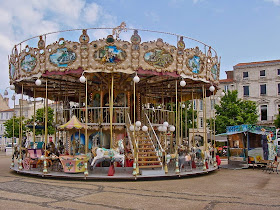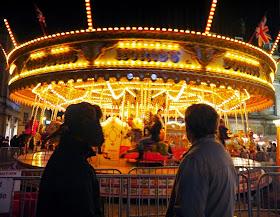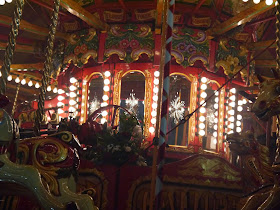Hello boys and girls! Are you sitting comfortably?
Duck here is going to take you on a tour of these beautiful machines, springing up all around the country at the moment and helping to create a magical festive atmosphere in some of the UK's best towns and cities.
In fact only this morning, one of them (the one above in fact) appeared in the centre of Bath where it'll be open for punters to take a ride until 14th December.
The first thing you need to know is that {shock horror} they're not called Carousels.
At least, 99% of the time the ones you'll see in the British streets aren't called carousels.
A carousel is a very European and American term, originating from either the French carrousel or the Italian carosello (depending on which story you believe). Typically they'll turn anti-clockwise and often have two levels to them, much like this picture from Wikipedia.
Source: Wikipedia
In Britain they're called Gallopers (or a set of gallopers if you want to use the full name). In comparison to carousels, British ones only have one level and always rotate in a clockwise direction.
The name gallopers came from an era when ordinary working people couldn't afford their own horse and escaping to the fair to ride on a horse which went round and round with a galloping motion was a much needed bit of fun in their day to day lives.
The other big giveaway is that on almost every ride (just like the one above), somewhere around the top will be written phrases along the lines of:
"glittering set of galloping horses"
"fleet of gallopers"
"golden gallopers"
"golden galloping horses"
(although just to confuse you further, a few showmen have painted the word 'carousel' on them as that seems to be what the majority of society know the ride as)
The first set of gallopers were produced in the mid to late 1800s by a company called Savages who were based in Kings Lynn. Savages ended up being pretty much the leader in gallopers and other fairground rides of that period, in fact most of the preserved rides you'll see nowadays from that era were produced by them.
There are still a few companies making the ride even today but obviously they don't hold quite the same nostalgia and history as the Victorian ones. The way to tell if a set is old or new is to look in the roof - if it's all wooden beams, then it's from a somewhat much earlier era; if it's all steel, then it's a replica ride produced in the last 30 or so years.
When they were made, most of the Victorian gallopers would have had an fairground organ in the middle of the ride playing all the popular chart hits from the 1890s. Most of them also would have been steam-powered and occasionally you'll still see one running on steam even today (look and see if there's anything coming out of the big funnel on top of the ride). Things have changed since the late 1800s though and all of the old sets of gallopers have been adapted to run on electric as well as steam. In the middle of the UK's Christmas markets, most of them will probably be running on electric and won't have a fairground organ inside - mainly because the organ is often worth more than the ride itself!
There are still a few companies making the ride even today but obviously they don't hold quite the same nostalgia and history as the Victorian ones. The way to tell if a set is old or new is to look in the roof - if it's all wooden beams, then it's from a somewhat much earlier era; if it's all steel, then it's a replica ride produced in the last 30 or so years.
When they were made, most of the Victorian gallopers would have had an fairground organ in the middle of the ride playing all the popular chart hits from the 1890s. Most of them also would have been steam-powered and occasionally you'll still see one running on steam even today (look and see if there's anything coming out of the big funnel on top of the ride). Things have changed since the late 1800s though and all of the old sets of gallopers have been adapted to run on electric as well as steam. In the middle of the UK's Christmas markets, most of them will probably be running on electric and won't have a fairground organ inside - mainly because the organ is often worth more than the ride itself!
Some of the things you'll see on or around a set of gallopers include...
Showman and Flattie
On the left - one showman (aka. David Downs in front of his gallopers - probably the nicest and most lovely showman you'll ever meet). A showman is simply someone who's been involved with the fairground for a long time, usually several generations worth of families.
On the right - one flattie (aka. Andrew - who would dearly love to be a showman). A flattie is the opposite - us lot who haven't been involved with the fairground world.
Tilt
If you look up inside the ride, the roof is covered with a large orange and yellow striped sheet - that's the tilt - basically the sheet which covers the ride.
Rounding Boards, Domes and Droppers
Look at the bit which says 'galloping', the flat bit around the edge of the ride at the top (the bit which usually contains the writing); these are the rounding boards (named for obvious reasons). Just above the rounding boards (the fancy decorative bit above the words) are domes and just below the wording (the intricate little mirror thingies) are droppers. The decoration and wording will probably be different on each machine you see and some rides sadly have even lost the fancy dome and dropper bits.
Swifts
Bit tricky to spot in this picture but if you look at all the beams of wood criss-crossing in the roof under the tilt, they're called swifts.
Flights
On the left - one showman (aka. David Downs in front of his gallopers - probably the nicest and most lovely showman you'll ever meet). A showman is simply someone who's been involved with the fairground for a long time, usually several generations worth of families.
On the right - one flattie (aka. Andrew - who would dearly love to be a showman). A flattie is the opposite - us lot who haven't been involved with the fairground world.
Tilt
If you look up inside the ride, the roof is covered with a large orange and yellow striped sheet - that's the tilt - basically the sheet which covers the ride.
Rounding Boards, Domes and Droppers
Look at the bit which says 'galloping', the flat bit around the edge of the ride at the top (the bit which usually contains the writing); these are the rounding boards (named for obvious reasons). Just above the rounding boards (the fancy decorative bit above the words) are domes and just below the wording (the intricate little mirror thingies) are droppers. The decoration and wording will probably be different on each machine you see and some rides sadly have even lost the fancy dome and dropper bits.
Swifts
Bit tricky to spot in this picture but if you look at all the beams of wood criss-crossing in the roof under the tilt, they're called swifts.
Flights
Fairly easy to see, flights are the pretty picture boards attached to the swifts and hanging down inside the ride. In the photo of the swifts above, the flights are all pictures of old English monarchs.
Centredrum
Mounts
The centredrum is literally the centre of the ride; in the picture above it's decorated in mirrors and if you look closely just to the left in front of them, you can see the top of the steam engine poking out.
Mounts
The most obvious bit of the ride - mounts are the horses. You'll also sometimes find cockerels (and possibly other magical beasts) and the most common type of galloper set is one with mounts which are 3-abreast. On old sets, the mounts were all hand carved in wood and creating a galloping horse was a complete artisan skill in itself. The most renowned company of carvers were Andersons of Bristol who started out making figureheads for sailing ships.
So there you go, everything you never wanted to know about those wonderful fairground machines (and if nothing else, it might come in handy for a pub quiz).
Having said all that though as well, if you do call it a carousel in front of a showman, they won't get annoyed or upset; all they'll do is just smile to themselves, roll their eyes and chuckle "ha, flatties" under their breath.
So, have you ridden on a set of gallopers recently?
(ps. if anyone from showland is reading this and wants to correct me, feel free to get in touch - I'm always up for learning new things!)

.JPG)
.JPG)

.JPG)
.JPG)
.JPG)






.JPG)

Oh wow i didn't realise this about our 'carousels' at all. Thanks for your great 'gallopers guide'.Very informative! I have ridden on one this year in Paris near the Eiffel tower. Couldn't resist! I'm presuming that was actually a carousel and not a galloper. Now i need to enjoy one here in blighty. :)
ReplyDeleteThis is brilliant. Now to find a pub with a fairground-themed quiz :) xxx
ReplyDeleteIt can take up to 8 hrs to put a set of gallopers together have it all built up and up and running
ReplyDelete